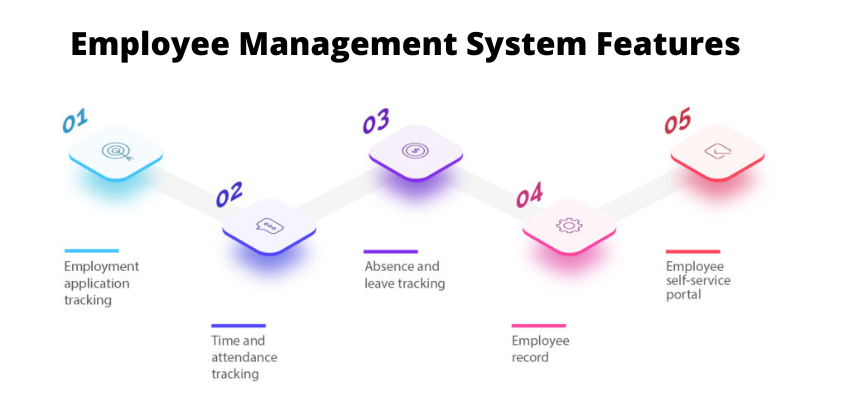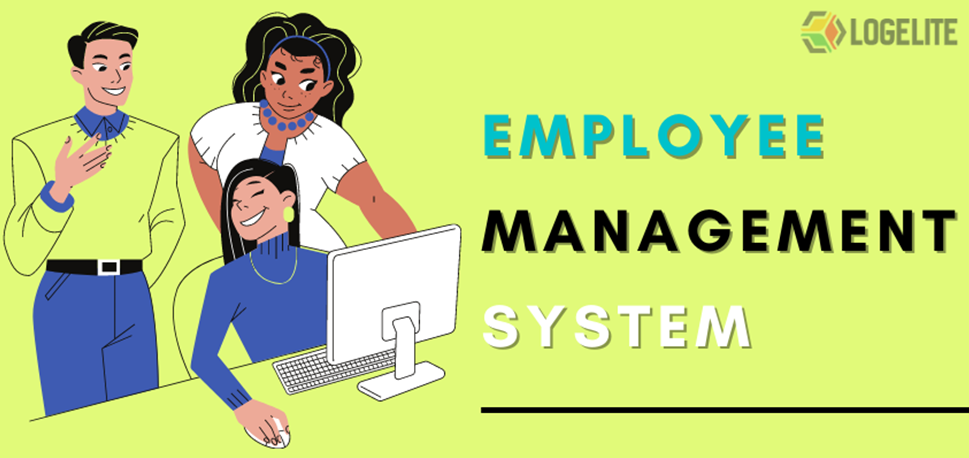In this article, we will discuss the employee management system (EMS). Many companies are adopting Employee management systems for their businesses. If you operate a startup with under a thousand workers, you cant handle them manually. If you opt to track the data and information manually, there are vast chances of errors and significant risks.
To avoid this risk, you require a system that may keep track of the work and smoothens the procedure. EMS is that kind of system and helps a lot. Stay tuned and keep reading this blog if you want to know more about it.
What is an employee management system?
An employee management system (EMS) is a distributed system designed to systematically manage employee data and company workflow processes. Employee Management System helps eliminate manual processes and saves a lot of money and time. An employee management system gives managers insights into their workforce. It helps them better plan and manage work hours to control labor costs and increase productivity quickly.
Why is an employee management system necessary for your business?
An EMS (employee management system) is specially designed to manage the business duties departmental-wise and streamline HR. Employee engagement systems are structured to monitor, assess, and control workers’ working timings and efficiently utilize human resources. Also, it helps ensure the payrolls are done on time.
As a business, all your employees are your true asset. Managing them is undoubtedly challenging, especially when the number of employees increases; it’s even harder to manage the entire workforce. Therefore, you need an employee management system that keeps all the processes on track.
EMS helps create an environment that encourages communication and keeps managers and employees working together. It helps to meet the motives of a company. A positive bond between managers and employees leads to better productivity, less conflict, more efficiency, and better retention. EMS (employee management system) is the most helpful thing for a company, and it’s essential when it comes to managing a remote workforce.

Advantages of the employee management system
Previously, people used to take the help of spreadsheets to manage HR processes and handle employees. Employees who work remotely can’t be in touch with HR because they are not often under the same place or roof. In this case, it s not possible to handle employees efficiently and keep them happy, engaged, and productive.
Besides, suppose remote workers have to inform or message their HR to mark their presence or call their seniors daily to record their working times. In that case, it may degrade the overall employee experience. Therefore, it’s important to shift toward modern, cloud-based systems and techniques that give a seamless working experience to all workers, no matter where they are working from.
A few of the common advantages of having an employee management system in your business or company are-
- Boosted profitability
- Higher motivation
- Lower costs Efficiency & better accuracy
- Less manual errors
- Higher productivity
- Less or fewer compliance risks
This is why the EMS (employee management system) is in trend nowadays. The employee management system (EMS) simplifies HR operations with centralized data and convenient automation. If you’re wondering if investing in an employee management system is worth it, check out how this solution may improve your business.
Supportive for remote employees
One of the most effective advantages of the employee management system is that it enables workers to work from anywhere at any time. They may complete onboarding, mark their attendance, fulfill training needs, apply for leave, raise requests, & access the documents of the company via the portal. HR can also use this system to share important announcements without any problem.
Simple & efficient HR process
Employee tracking systems can significantly reduce the need for manual data entry. Instead of wasting time on HR-related emails, spreadsheets, and phone calls, you can free up your HR team and employees to spend time on important projects. All employee management processes, from recruitment to offboarding, may be easily automated, simplified, and tracked via the application.
For example, employees can record attendance through the system, request vacations, and automatically retrieve and store the same information for later use in payroll. Employees can also ask questions, make requests, and track time and attendance status through the system. The HR team may also assign agents to respond to requests. Further, HR managers may create and assign employee shifts and automate shift rotations from the system.
Improved productivity and engagement
Employee management systems help maintain employee engagement and productivity. For example, the software’s live feed features can enable users to have a chat with a colleague at any moment. Similarly, employees can keep everything happening within their organization up to date. You may also track the status of each request and provide feedback.
In addition, the onboarding feature allows new employees to learn everything they require to know about their new roles and organization. Overall, the employee management system (EMS) supports open communication, which is key to improving employee engagement. An efficient employee management system streamlines employee performance management, which boosts productivity.
Employees can use the software’s cloud-based learning management system to learn new skills and choose a learning style and pace that suits their tastes. Managers can use this system to set goals for team members, and both parties can effectively monitor progress. Additionally, employees can give and receive feedback on their work. All of these factors play an essential role in maximizing the potential of our employees.
Secure and centralized employee data
As a recruiter or HR, you handle vast amounts of data. Few of these data can be sensitive, and managing them carefully to avoid compliance issues, and associated penalties is essential. Other data should be documented at every step to ensure compliance with national and local labor laws. The employee management system (EMS) centralizes all data related to HR operations and automatically documents it to the platform.
All data is readily available and accessible from anywhere, so organizations are always ready for HR audits. User access control settings allow only users with the appropriate access level to process data. It prevents the data from being misused. Logelite provides the most efficient employee management system.
Disadvantages of the employee management system
Although EMS comes with several benefits, it has various disadvantages as well, such as:
Higher risk of internal competition
Under this system, employees started to compete with each other for position, status, and salary. It may lead to discomfort, lack of communication among teammates, and aggressive staff competition. It can lead to departmental and team dysfunction and failure to meet performance criteria. It is the most significant risk of the employee management system.
Favoritism
Managers and supervisors typically trust and rely on one employee more than the rest. The foreman or the team leader could be this worker. This employee is in charge of outlining new job responsibilities to other staff members. It causes mistrust and disagreement among the group’s participants.
It disrupts teams and negatively affects employee satisfaction and morale. “Why should I even attempt when the supervisor would only trust Employee A?” is the mentality. This is also one of the significant disadvantages of the employee management system.
Time-consuming and expensive
Employee management systems are expensive and require much patience, time, and administrative work. Areas that are adversely affected typically include human resources, organizational development, and finance. Employee management requires employees to acquire the “right” knowledge and skills.
It includes conducting extensive training, retraining, and career development workshops for all division & employee levels. It turns out to be an expensive procedure. Further, projects are lost as workers are getting trained with newly improved skills. It means a negative organizational performance as the time employees could have been working was spent in a workshop.
Complex and bureaucratic
The company will eventually hire and train new staff. Employee management creates a new organizational level. The number of employees will increase. Now, two teams will run the project instead of one team running it. It harms or affects the financial structure of the organization.
What are the features of the employee management system?
Employee database management
The system of choice must have an employee database management platform that can centralize HR data for each department, region, and business unit. With this feature, you may manually add employee data or synchronize data from compatible third-party applications in just a few steps.
A good system allows employees to be categorized by department, location, and designation to facilitate data management. Employees can also edit and access personal details to ensure accurate records.
Attendance, timing, and leave management
Employee management systems (EMS) should help organizations streamline and automate their time management tasks. It should have a robust attendance and management system that allows employees to mark attendance and send vacation requests from anywhere. A good system helps track check-in times, check-out times, overtime, vacation credits, service information, and user rights for all employees.
It also simplifies payroll processing with the ability to capture accurate attendance and absence data. Employee management systems should also include online timesheets so that workers can track their time on various projects.
Performance management
A strong performance management system is one of the critical characteristics to look for in an employee management system. This factor helps you and your leaders clearly understand where each employee stands in terms of performance.
You should be able to conduct routine performance reviews by your organizational needs, and it should be possible for employees to complete self-evaluations and get constructive criticism from colleagues and managers. A good performance management system helps to support modules such as motives, KRA (key responsibility area), competencies, and skills to help you perform fair performance reviews.
Conclusion
Employee management is the core business process that seeks to improve profitability. Remember that the most valuable resource in your company is human capital. Whether or not to harness this talent depends on HR management and corporate culture. After reading this article, I hope you have learned many things about the employee management system. Follow the tips and processes outlined here, and you will have no problem converting a good employee into your best employee

Comment
Write a Reply or Comment